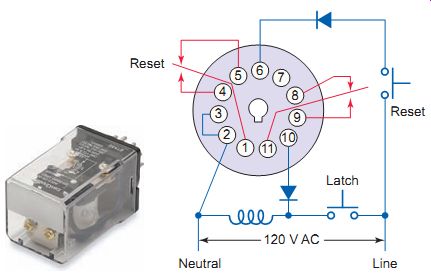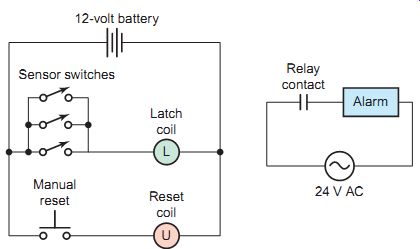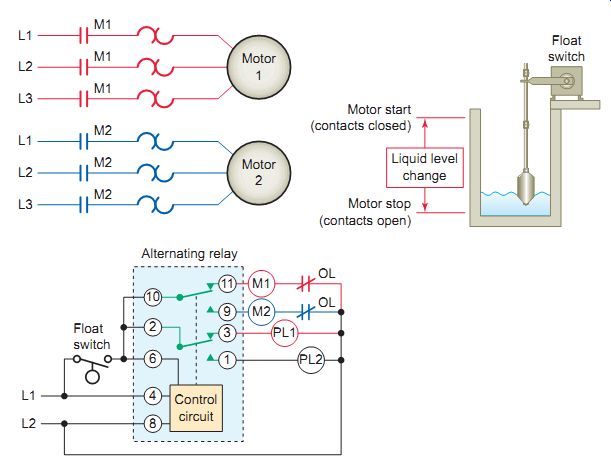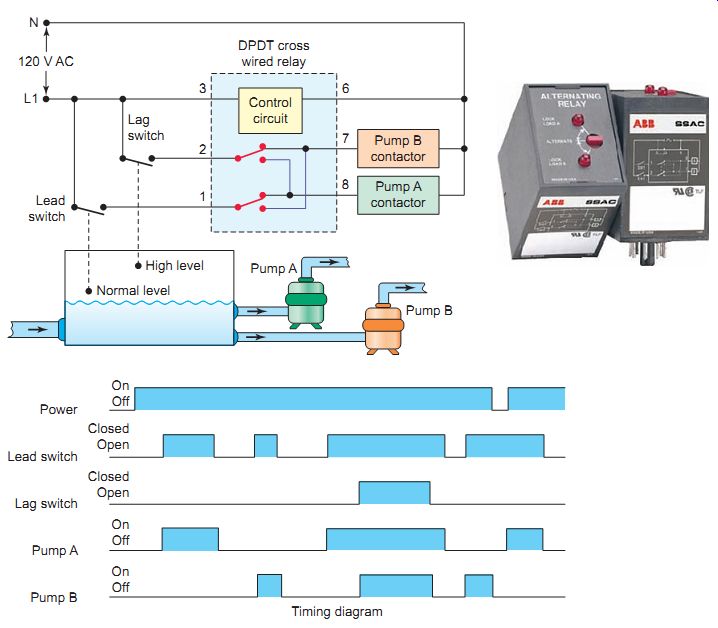AMAZON multi-meters discounts AMAZON oscilloscope discounts
Cont. from part c
Latching Relays
Latching relays typically use a mechanical latch or permanent magnet to hold the contacts in their last energized position without the need for continued application of coil power. They are especially useful in applications where power must be conserved, such as a battery-operated device, or where it’s desirable to have a relay stay in one position if power is interrupted.

Ill.26 Two-coil mechanical latching relay.

Ill.27 Operation of a two-coil latching relay circuit. Relay contact
(unlatched state)
Mechanical Latching Relays
Mechanical latching relays use a locking mechanism to hold their contacts in their last set position until commanded to change state, usually by energizing a second coil. Ill.26 shows a two-coil mechanical latching relay. The latch coil requires only a single pulse of current to set the latch and hold the relay in the latched position.
Similarly, the unlatch or release coil is momentarily energized to disengage the mechanical latch and return the relay to the unlatched position.
Ill.27 illustrates the operation of a two-coil mechanical latching relay circuit. There is no "normal" position for the contacts of a latching relay. The contact is shown with the relay in the unlatched condition- that's , as if the unlatch coil were the last one energized. The operation of the circuit can be summarized as follows.
• In the unlatched state, the circuit to the pilot light is open, so the light is off.
• When the on button is momentarily actuated, the latch coil is energized to set the relay to its latched position.
• The contacts close, completing the circuit to the pilot light, so the light is switched on.
• Note that the relay coil does not have to be continuously energized to hold the contacts closed and keep the light on. The only way to switch the lamp off is to actuate the off button, which will energize the unlatch coil and return the contacts to their open, unlatched state.
• In cases of power loss, the relay will remain in its original latched or unlatched state when power is restored. This arrangement is sometimes referred to as a memory relay.
Magnetic Latching Relays
Magnetic latching relays are typically single-coil relays designed to be polarity sensitive. When voltage is momentarily applied to the coil with a predetermined polarity, the relay will latch. A permanent magnet is used to hold the contacts in the latch position without the need for continued power to the coil. When the polarity is reversed, and cur rent momentarily applied to the coil, the armature will push away from the coil, overcoming the holding effect of the permanent magnet, causing the contacts to unlatch or reset.
Ill.28 shows a single coil magnetic latching relay used with an 11-pin octagon-base plug-in socket. The direction of current flow through the coil determines the position of the relay contacts. Repeated pulses from the same input have no effect. The DPDT relay contacts can handle control circuit loads and are shown with in the relay reset position.

Ill.28 Single-coil magnetic latching relay. Reset Line Latch Neutral;
120 V AC

Ill. 29 Battery-operated latching alarm circuit. Latch coil ; Sensor switches;
Reset coil; Manual reset; L; 12-volt battery; Alarm Relay; contact; 24
V AC
Latching Relay Applications
The latching relay has several advantages in electrical circuit design. E.g, it’s common in a control circuit to have to remember when a particular event takes place and not permit certain functions once this event occurs.
Running out of a part on an assembly line may signal the shutdown of the process by momentarily energizing the unlatch coil. The latch coil would then have to be momentarily energized before further operations could occur.
Another application for a latching relay involves power failure. Circuit continuity during power failures is often important in automatic processing equipment, where a sequence of operations must continue from the point of interruption after power is resumed rather than return to the beginning of the sequence. In applications similar to this, it’s important not to have the relay control any devices that could create a safety hazard if they were to restart after a power interruption.
Latching relays are useful in applications where power must be conserved, such as a battery-operated device. Ill. 29 shows a simplified diagram for a battery- operated latching alarm circuit. The circuit uses a latching relay to conserve power. Regardless of whether the circuit's reset or latched there is no current drain on the battery. Momentarily closing any normally open sensor switch will cause the relay to latch, closing the contact to power the alarm circuit. The manual reset button must be depressed with all sensors in their normally open state to reset the circuit.

Ill.30 Alternating or impulse relay. Control switch; 120 VAC / VDC; Ill.31
Typical alternating relay circuit used with a duplex pumping system. Input
voltage
Alternating Relays
Alternating relays (also known as impulse relays) are a form of latching relay that transfers the contacts with each pulse. They are used in special applications where the optimization of load usage is required by equalizing the run time of two loads. Ill.30 shows a plug-in alternating relay made up of a magnetic latch relay that's operated by a solid-state steering circuit. The operation of the circuit can be summarized as follows.
• An external control switch such as a float switch, manual switch, timing relay, pressure switch, or other isolated contact initiates the alternating action.
• The input voltage must be applied at all times and the S1 control switch voltage must be from the same supply as the unit's input voltage (no other external voltage should be connected to it).
• Each time control switch S1 is opened, the output contacts will change status. LEDs indicate the status of the internal relay and which load is selected to operate.
• Loss of input voltage resets the unit; load A becomes the lead load for the next operation.
• To terminate alternating operation and cause only the selected load to operate, the toggle switch located on the top of the relay is shifted to position A to lock load A or to position B to lock load B. This feature allows users to select one of the two loads or alternate between the two.
In certain pumping applications, two identical pumps are used for the same job. A standby unit's made avail able in case the first pump fails. However, a completely idle pump might deteriorate and provide no safety mar gin. Alternating relays prevent this by assuring that both pumps get equal run time. Ill.31 shows a typical alternating relay circuit used with a duplex pumping sys tem where it’s desirable to equalize pump run time. The operation of the circuit can be summarized as follows.
• In the off state, the float switch is open, the alternating relay is in the load A position, and both loads (M1 and M2) are off.

Ill.31 Typical alternating relay circuit used with a duplex pumping system.

Ill.32 DPDT cross-wired contact version of a dual pumping application.
QUIZ:
1. What two methods are used to hold the contacts of a latching relay in their last energized position?
2. Explain how a two-coil mechanical latching relay is latched and unlatched.
3. In what state are the contacts of a latching relay normally shown on diagrams?
4. Explain how a single-coil magnetic latching relay is latched and unlatched.
5. Assume that power is lost to a circuit that contains a latching relay. In what state will the contacts be when power is restored?
6. In what type of applications are alternating relays used?
7. What additional operating feature is available for use with cross-wired alternating relays?